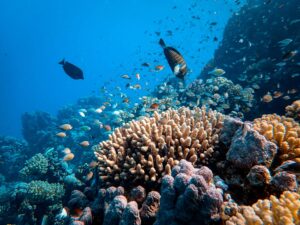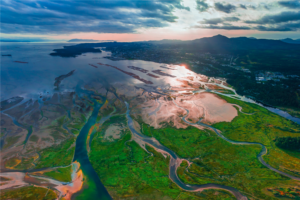How can we better manage our common water resources?
Ensuring Water Resilient Cities
The second webinar highlighted the importance of ensuring water resilient cities, especially in the light of climate change impacts.
Panchali Saikia at SIWI kicked off the session by introducing the City Water Resilience Approach, developed by SIWI and Arup.
Panchali also discussed what urban water resilience actually means. She stressed that we need to look beyond the climatic aspects, and also consider economic, government, and health related shocks that might affect water resilience. Panchali continued by explaining that cities draw upon large catchment areas, which often lie outside the city’s jurisdiction and control. Therefore, collaboration is critical to overcome scale problems and take a holistic integrated approach by considering the whole water cycle, and not only water regulation but also land regulation.
Lykke Leonardsen at C40 Cities and Copenhagen City dove further into the importance of multidisciplinary collaboration between stakeholders to ensure water resilient cities. Water management in cities is complex, as there are many different stakeholders involved, and because water crosses both administrative and geographical boundaries. By giving examples from Copenhagen, Lykke highlighted the importance of adaptive planning. Both cities and the climate are changing, and development plans for cities also need to be able to change over time.
The third and final speaker, Pär Svensson at Malmö City, presented the journey Malmö has made towards becoming more resilient to cloudbursts and floods. In 2014, Malmö was hit with a ‘300-year rain event’. Since then, the concept of water resilience and consideration of cloudbursts has been integrated as the ‘new business as usual’ in all their city planning projects, and data and models has been made available for all civil servants.
Pär posed the question “How can we manage our future needs today?”, and stated that sometimes the best measure is to ensure that future adaptation is not made impossible. In line with Lykke, Pär also emphasized the need for adaptive planning and flexible solutions that can change over time, especially with regard to climate change impacts.
Strengthening climate resilience in agriculture
The third and final webinar in the series explored how water-smart solutions can strengthen the climate resilience of agricultural landscapes.
SIWI’s Anna Tengberg introduced the audience to the topic, and explained why water-smart solutions are needed in agriculture. Water scarcity and water quality issues are increasingly threatening food security and nutrition. Water-smart approaches, such as agroforestry and soil fertility management, enhance the climate resilience of landscapes. Anna highlighted that a key factor for success is an enabling environment that supports knowledge production and awareness raising, and that puts the policy and regulatory frameworks required in place. More information and examples of soil and water conservation practices around the world can be retrieved from the World overview of conservation approaches and technologies.
The next speaker, Monica Nderitu at Vi Agroforestry’s regional office in Kenya, presented how agroforestry can aid wise water management and support productive agricultural lands. One of the biggest threats to development in Kenya is climate change, which can cause effects such as heavy rainfalls, droughts, floods, and soil erosion. By applying land practices such as agroforestry, water-related benefits, including regulation of water flows, and improved soil fertility and water quality, can be supported. Monica presented one of Vi Agroforstry’s projects, ‘SEMA’, in the transboundary area between Kenya and Tanzania. Besides improved water and soil management, the project also aimed at empowering local stakeholders, providing sustainable livelihoods, and promoting regional dialogues, cooperation and community involvement.
Tette Alström at Ekologigruppen, the final speaker of the webinar, explained that in Sweden, there has been an increasing interest in wetlands for irrigation among the farmers since the dry summer of 2018. She emphasized the growing need for irrigation systems and to secure water in the landscape to ensure plant growth. It is essential to find common strategies and for stakeholders to work together within catchments. In Sweden, there are so called ‘water councils’ (‘vattenråd’), that gathers stakeholders on the local scale to make use of local knowledge and develop common solutions. These water councils are good examples of successful collaboration for improved water management, and should be further developed.
Key messages
How can we better manage our common water resources, to ensure healthy ecosystems and access to water?
The three webinars provided a clear picture of that water resources are put under increased pressure, but also that there already are solutions and measures in place that can be further developed. To advance this work, these key messages from the webinar series must be considered:
- There is a need for a holistic approach to water management, that includes land systems, freshwater systems, estuaries, deltas, coastlines, and seas.
- Cooperation and collaboration are key to identify problems and solutions that benefit multiple stakeholders across administrative and geographical borders.
- Measures need to be adaptive and flexible to withstand future pressures such as climate change impacts.
- Inclusion of local stakeholders is essential to gather knowledge and develop solutions together.
- Behavioral change is a key factor to ensure long-term success of projects that entail changed land and water practices.
- There is a need for more documentation of measures and their effects, in order to develop efficient tools and solutions.
- Existing tools, data and knowledge need to be made available for stakeholders to make informed decisions.
- Financial mechanisms and regulatory frameworks must enable the implementation of measures.









